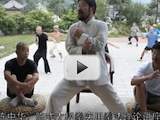Main Points:
- Taijiquan movement is characterized by a continuous outward thrust
- Taijiquan movement is like the movement of a car engine – only one kind of motion should be present, but because of the structure of the vehicle, it can transform the engine motion into a variety of trajectories.
- The thrust is a far less instinctual movement for human beings, but is far stronger and safer than the slash. Correct thrusting saves the joints, while slashing and hooking motions can harm them.
- (my note, not Master Chen’s) According to American Army Lt. Col. Dave Grossman, historically the Romans had a senior officer behind every line of fighting soldiers reminding them by yelling and striking them that they must thrust with their swords and not slash. (Grossman, D. On Combat. 2004. PPCT Research Publications). Sorry I can’t recall the page number.
- There is a visual centre and a functional centre. The visual centre is the centre of mass in the body, while the functional centre between two bodies can actually fall almost anywhere.
- Master Chen covered a variety of drills. They seemed to fall into two categories:
- Non-contact drills – avoiding an incoming strike by moving the centre of mass well out of the way and striking an exposed flank. Very quick response based on filling negative space
- Contact-drills – manipulating your own structure to effect change on another body through a point of contact. Slow tactile drills based on precision and accuracy
- 8 Parts Theory. Master Chen presented the 8 Parts theory again, and linked it to his idea above about the ‘car-engine metaphor’, saying any one ‘firing of the piston’ is responsible for moving only 1/8 of the total possible range of movements.
Short notes for now. I will post more when I have some time to fully transcribe my notes.



{ 3 comments… read them below or add one }
Daniel, Thanks for the notes. The main thing I wanted to say is that the job of Taijiquan training (which was called smeltering, some people mistakenly call it nurture) is to cause a conversion of energy from the normal type to another. If the conversion is achieved, we say that the person has gotten it.
Hi Master Chen,
Thanks for posting these. Does your comment above mean that if one can ‘get’ the piston motion, we are beginning to make that conversion?
Daniel
If you can get the piston motion, you are ready for the next step. The piston motion must be kept constant without any diviation. Then one has to add something else to begin the conversion. The common flaw is to change the piston motion INTO another type of motion. An example is to change the straight motion of the two feet pushing into the ground into a circular motion.